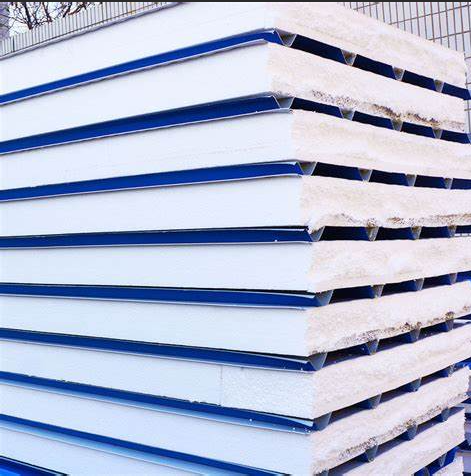Introduction
Among the varieties of construction materials, fireproof sandwich panels are distinguished with a unique combination of thermal insulation, strength, and limited combustibility. These are more demanded because of safety and fire regulations. This guide will outline some common questions regarding purchasing and installing fireproof sandwich panels in an attempt to provide builders, architects, and property owners with the knowledge they need to make informed decisions.
What Makes Sandwich Panels Fireproof?
Fire-rated insulating sandwich panels are comprised of two layers of material, usually metal (but not always) and a core layer designed to hold up to fire. It is also available with cores made of mineral wool or polyunsaturate, both of which are recognized for their fire-resistant qualities. These panels demonstrate high thermal insulation properties, sturdiness at elevated temperature and minimal smoke emission making them perfect for fire-prone environments.
How to Buy Fireproof Sandwich Panels?
There are various factors that need to be taken into account when you go for fireproof sandwich panels. Panels need to comply with the fire-safety codes. Fire performance of a given product is typically indicated by certifications such as ASTM E84 or EN 13501-1. Assessing suppliers includes their reputation, product quality, and the ability to provide technical support and after-sales service.
Installation Process
Installing solar panels starts with careful planning and design so that they best fit the body of the building. The real set-up, or installation is when they fasten the panels to the frame of a building and seal it all up in such a way that there are no openings for smoke and flames to travel between them. The only tools that you are going to need for the installation of one will be power drills, screwdrivers, and sealant guns. Proper handling may also ensure the panels will still meet their fire-resistant standards.
Familiar Install Problems
Another thing that can come up during installation is the gap between panels, or how to support weight for windows or doors and before these gaps do too many cuts. This can be avoided by utilizing fire-resistant sealants and tapes to seal gaps, as well as sufficiently supporting the panels to protect their structural integrity. Always try to avoid making custom cuts on the panels, as those may weaken its original purpose of fireproof.
Safety and Compliance
It is imperative to comply with local codes and fire safety standards. The panels must be securely sealed against penetration of fire. Employing fireproof materials for every part of the building envelope ensures that the advantages inherent in panels aren't nullified through neighboring elements.
Maintenance and Durability
Note that timely inspection and maintenance are critical to fireproof sandwich panels as long-term use. This includes looking for any weather or impact damage and making sure all of the seams are tight. Even with proper maintenance, the longevity of those panels can surpass 25 years, which is one of the best cost-effective solutions for fire safety.
Cost Considerations
Although the upfront cost of fire resistant sandwich panels is higher than conventional materials, savings from energy efficiency and lower insurance premiums can mitigate The latter expense. When you look at the total cost of ownership over time, with maintenance and avoiding possible costly fire damage considerations included, fire resistant sandwich panels are usually a very smart decision.
Environmental Impact
Fireproof sandwich panels are considered on an environmental basis also. Several manufacturers are concentrating on sustainable production methods and the use of recyclable materials. Through energy efficiency and minimizing waste, the panels add value towards green building initiatives.
Fireproof Sandwich Panel Innovations
The field of fireproof materials is also in continuous evolution with more research and development on fire-resistance technologies for existing or new reproducible valuable applications. SMC panels are being supplemented with advances like in-tumescent coatings, which expand in volume and can provide additional fire protection when exposed to heat.
Case Studies and Examples
Studying examples of buildings that have successfully employed fireproof sandwich panels supplies practical tips. The panels are used in so many applications that these instances highlight the ingenuity with which they have been incorporated into architectural design.
How To Choose The Right Fire Proof Sandwich Panels
Choosing the Appropriate Panels: Match the specifications of panels with your project requirement. It is necessary to partner with professionals who can draft customized solutions based on performance data. Having a proper reevaluation of the product capabilities provides insight in making educated choices that will guarantee the panels work to spec in case of a fire.
Conclusion
Fireproof sandwich panels provide an integrated approach to fire safety in construction. It is important to know what they are made up of, things you need to factor in before purchasing them, how they are installed and when you should maintain them so that you get the most out of using these products. With the rapid pace of technological advancements, these panels will only get better and become further integral to modern construction.
Table of Contents
- Introduction
- What Makes Sandwich Panels Fireproof?
- How to Buy Fireproof Sandwich Panels?
- Installation Process
- Familiar Install Problems
- Safety and Compliance
- Maintenance and Durability
- Cost Considerations
- Environmental Impact
- Fireproof Sandwich Panel Innovations
- Case Studies and Examples
- How To Choose The Right Fire Proof Sandwich Panels
- Conclusion

 EN
EN







































